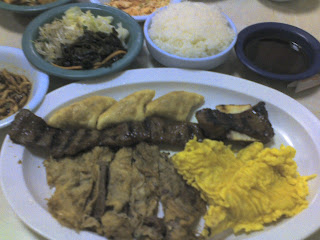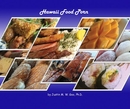Usually when I'm travelling, I never want to eat something that I could get at home. I have never understood why, after travelling thousands of miles, tourists would want to eat at McDonald's and waste the opportunity to try something you couldn't get at home. But when my Korean friends come from the mainland, I still like to take them to eat our local Korean food, just to showcase how different it is here from the Korean food you'd find on the mainland or in Korea. Usually they are pretty surprised. In fact, one friend didn't even recognize the kalbi she was eating as kalbi. The style of kalbi that we're so used to, the thin cross cut with the 3 bones at the top, is completely different from how kalbi is cut in Korea. Though different, it is just as legitimately Korean as food from Korea, just developed independantly for over 100 years by our own local Koreans.
Shoyu Chicken & Mochiko Chicken Mixed Plate from UH Lunchwagon
Local Korean food is all over the islands, even if not in a Korean restaurant. Spicy Korean chicken drummets, or our beloved 3-boned kalbi for that matter, are standard plate lunch fare and can be found at any diner or lunchwagon. Kim chee is ubiquitous, but not necessarily in the places that you'd expect. The lunchwagon over at UH for example always serves a small bit of kim chee with any mixed plate, regardless of what other items are chosen. Ted's Drive-In at the top of the hill on S. King St. (across from the Humane Society), used to be famous for serving their kim chee burgers. Sadly they've long since closed, but Old Waialae Road which replaced them continues the tradition. Big City Diner also features kim chee, in their Grandma's Famous Kimchee Fried Rice. But for the real local Korean flavor, the place that I would always go to are the Kim Chee Restaurants.There are actually quite a number of them around the state. The one that I am most familiar with, the one that I grew up with, is Kim Chee II, right next to Big City Diner in Kaimuki. Ever since I was little, I loved that place. Even waiting for a table, I have fond memories of staring at their little diorama of the mongoose trying to attack the pheasant. Their rice to me, is some of the softest, biggest, stickiest, plumps of white pearls I've ever had, and when I was away at college on the mainland, this was the rice that I was missing. But after I came home from college, we started frequenting the other Kim Chee Restaurants as well. After attending any large expos at the Neil Blaisdell Center, we discovered that we really liked Kim Chee III, tucked away across from Thomas Square (not at all visible from King St.). When I was working for a client on Kauai, I had the chance to try Kim Chee No. 9 in the Kukui Grove Shopping Center. But to me, the best one is the original one. Kim Chee No. 1, over in Kaneohe, right on Kamehameha Hwy. just before Windward Mall. They are the original and still clearly the best one. Their portions are just a bit larger than all of the others. Their flavors are just a bit more intense. They are probably the best definitve example of local Korean food. But all of them are pretty good.
Barley & Corn Tea at Kim Chee II
When wandering in to a Kim Chee Restaurant, the first thing that you notice is that you can make yourself feel at home. They let you meander over to the boiler and get your own cup of Korean barley & corn tea. I love this tea, because it doesn't taste like any other tea in the world. In fact, it's not brewed with tea leaves at all. It's brewed with, well, barley and corn. The barley gives it the earthy backbone, but it is the corn that sweetens it up. Koreans drink it like water.Seaweed Soup at Kim Chee II
No matter what you're having, the first thing you get is their seaweed soup. It's a very simple, salty little clear broth. But the deep flavor of the seaweed shines through. There is also just a hint of the meat bones they probably used to make the stock with.2 Types of Kim Chee at Kim Chee II
As a Kim Chee restaurant, you have to have kim chee of course. I have always liked that crunchy gourd kim chee better than the regular one. Besides that great crunch, it's got just a bit of sweetness and a little bit of spiciness to give it a kick. To be honest, their regular kim chee is just too mild. It's kind of a blend between kim chee and the tsukemono you get at local Japanese places. They toned it way down, and it is just a little too bland for me. However, I'll let you in on a secret. They do make the real stuff as well. You have to ask them for their "special" kim chee, the ones they usually only serve to their Korean patrons. Then they bring out the much spicier, much more intense, slightly sour, slightly briney, authentic kim chee.Special Kim Chee vs Regular Kim Chee at Kim Chee II
Then comes the matter of what to actually order. But if you're like me and just can't decide, they've got a number of special combination plates, with a sampling of their best stuff. My favorite thing there is their dinner special. The shrimp "tempura", is decent, but when you dip it in that salty, spicy dipping sauce they give you, it just comes alive. I've never really cared for mandoo, as much as I like gau gee or gyoza. The pi (or wrapper) on a mandoo is always too thick and way too chewy for my taste. But the mandoo at kim chee also has a pretty satisfying crunch to it. The hearty crunch in combination with the thick chewiness makes their mandoo a lot more tasty than others. But the 2 things that I absolutely adore at Kim Chee Restaurants are their meat jun and their kalbi. The meat jun has a fantasticly addictive egg batter on it that just soaks up all of the meaty flavors, juices, and seasonings. The kalbi is actually cut both ways. In some dishes, it is the local style, thin cross cut with the 3 bones at the top. But on their dinner special, it is a strip cut, with a single whole bone at the end. The sweet and savory kalbi marinade at the Kim Chee Restaurants is simply the best there is. I once had a bad steak at regular steak place. It was kinda tough and dry and all around tasteless. So the next day, I had an immediate craving for the juicy, flavorful strip of kalbi at Kim Chee, and the difference was like night and day. They may be completely different from their current counterparts in Korea, but to me the meat jun and the kalbi at Kim Chee are second to none. They are my favorite kalbi and meat jun, and my favorite Korean dishes, anywhere. Dinner Special at Kim Chee II
After a hundred years of evolution, even though from a common point of origin, the Korean food and culture in Hawaii are unique and independant on their own. But, it is a difference worth celebrating and preserving, as a distinct and local identity.









No comments:
Post a Comment